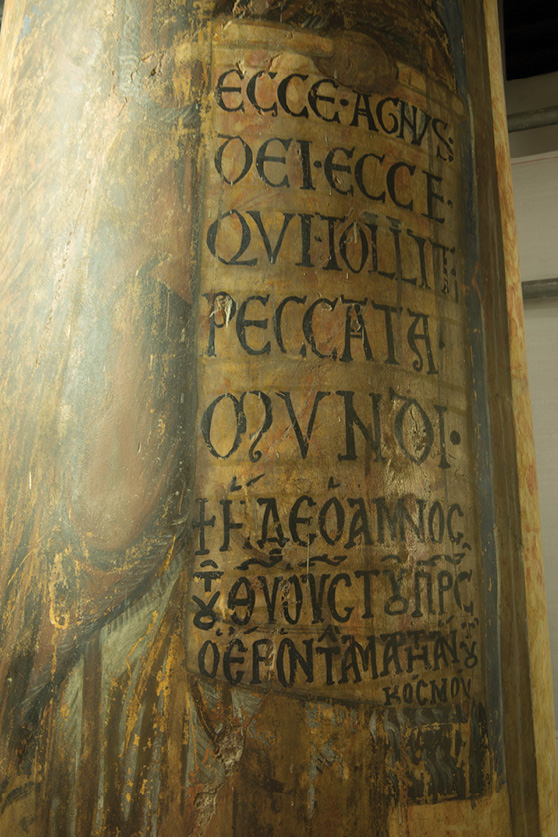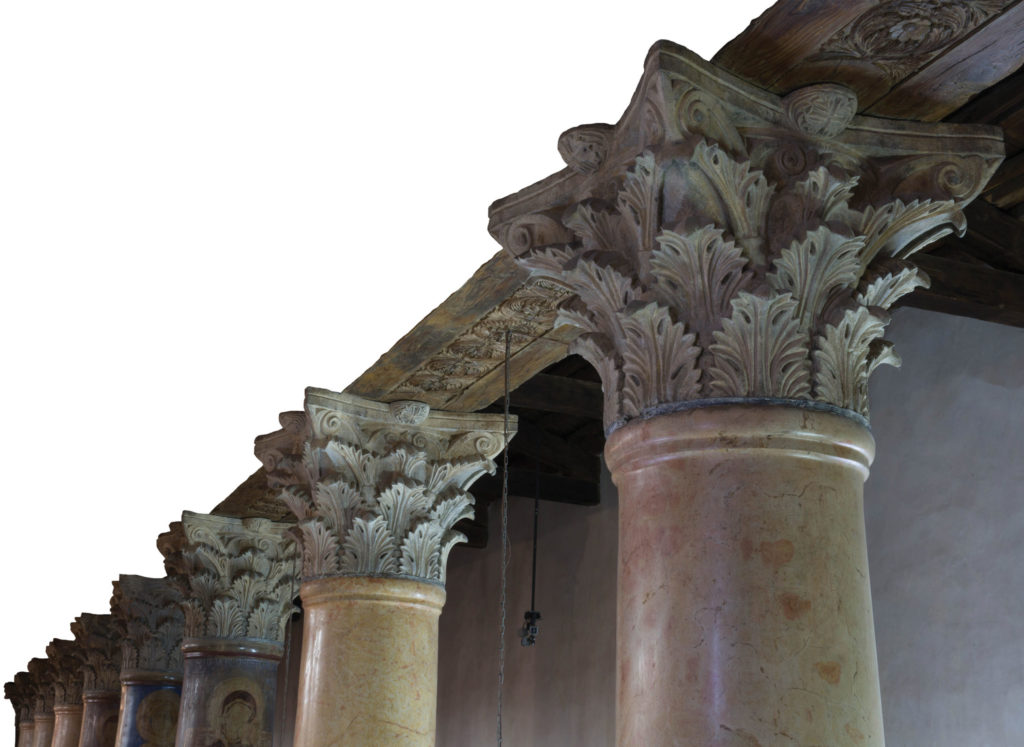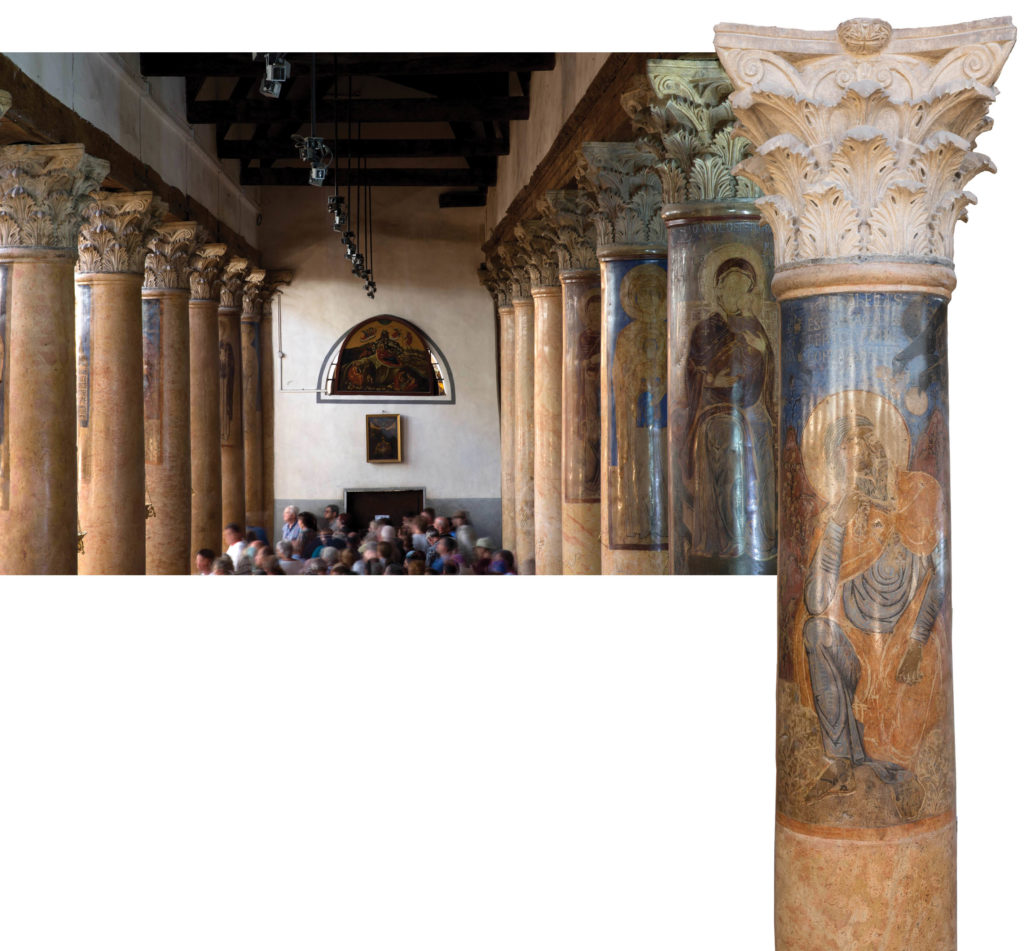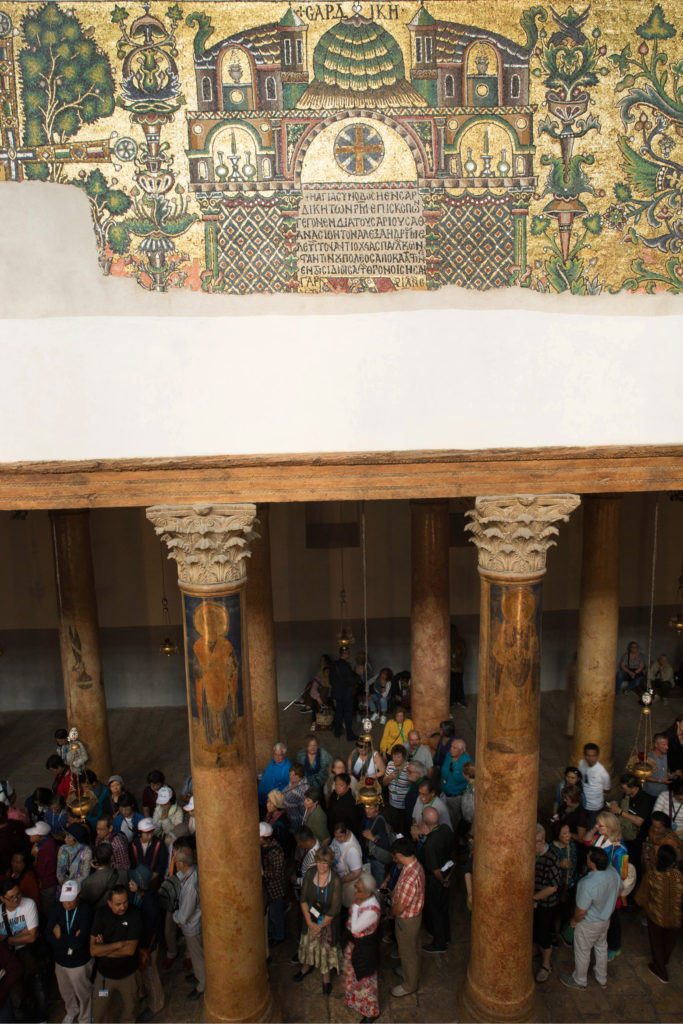الأعمدة
– Les colonnes
– Die säulen
– las columnas
– Le colonne
– Колонны

EN. The Basilica of the Nativity was rebuilt by the emperor Justinian in the sixth century. The fifty stone columns have capitals with vegetal patterns that used to be covered with golden foil. Above, visitors can see the detail of one of the paintings with the inscription “Ecce Agnus Dei.”
تم إعادة بناء كنيسة المهد في عهد الإمبراطور يوستينيانس في القرن السادس. فيها خمسون عمودًا من حجر، وتيجان الأعمدة محفورة بدقة بأشكل أوراق نباتية كانت سابقا مغطاة بورق الذهب. على اليسار، يمكن مشاهدة أحد الرسومات وعليه كتابة لاتينية تعني هو ذا حمل الله
FR. La basilique de la Nativité fut reconstruite par l’empereur Justinien au VIe siècle. Les chapiteaux de ses cinquante colonnes en pierre sont finement gravés de motifs végétaux qui étaient autrefois dorés à la feuille d’or. Sur la gauche, les visiteurs peuvent voir le détail d’une des peintures portant l’inscription « Ecce Agnus Dei ».
DE. Die Geburtskirche wurde im sechsten Jahrhundert von Kaiser Justinian gebaut. Die fünfzig Steinsäulen haben Kapitelle, in die vegetative Muster kunstvoll eingraviert sind. Früher waren sie mit Blattgold überzogen. Besucher können zur linken Seite die Inschrift „Ecce Agnus Dei“ („Seht das Lamm Gottes“) in seiner Ausführlichkeit auf einem Gemälde sehen.
ES. La Basílica de la Natividad, reconstruida por el emperador Justiniano en el siglo VI, cuenta con 50 columnas de piedra. Los capiteles, finamente tallados con motivos vegetales, estaban cubiertos con papel de oro. A la izquierda se puede ver el detalle de una pintura con la inscripción ‘Ecce Agnus Dei’ (He aquí, el Cordero de Dios).
IT. La Basilica della Natività, ricostruita dall’Imperatore Giustiniano nel VI secolo, conta 50 colonne in pietra. I capitelli, finemente intagliati con motivi vegetali, erano ricoperti da foglia d’oro.
A sinistra il dettaglio di una delle pitture con l’iscrizione “Ecce Agnus Dei”.
RU. Базилика Рождества была перестроена императором Юстинианом в шестом веке. Пятьдесят каменных колонн имеют капители с тонко выгравированными растительными узорами, которые раньше были покрыты золотой фольгой. Слева посетители могут увидеть детали одной из картин с надписью «Ecce Agnus Dei» (“Вот Агнец Божий”).


EN. During the twelfth century, the columns in the nave were decorated with a series of tempera paintings that represent saints. The column on the right bears an image of the prophet Elijah in the desert.During the twelfth century, the columns in the nave were decorated with a series of tempera paintings that represent saints. The column on the right bears an image of the prophet Elijah in the desert.
خلال القرن الثاني عشر، تم تزيين الأعمدة في صحن الكنيسة بسلسلة من الرسومات المائية تمثل القديسين. على العامود الموجود على اليمين، صورة للنبي إيليا في الصحراء
FR. Les colonnes des nefs furent décorées au XIIe siècle d’une série de peintures à la détrempe représentant les saints. La colonne de droite porte une image du prophète Elie dans le désert.
DE. Während des zwölften Jahrhunderts waren die Säulen im Mittelschiff mit einer Reihe von Tempera-Bildern verziert, auf denen Heilige dargestellt waren. Auf der Säule zur Rechten ein Bild mit dem Propheten Elias in der Wüste.
ES. Las columnas de la nave fueron decoradas durante el curso del siglo XII con una serie de pinturas al temple representando a los santos. En la columna de la derecha lleva la imagen del profeta Elías en el desierto.
IT. Le colonne delle navate furono decorate, nel corso del XII secolo, da un ciclo di pitture a temperara raffiguranti santi. La colonna a destra raffigura il profeta Elia nel deserto.
RU. В двенадцатом веке колонны в нефе были украшены серией темперных картин, изображающих святых. На колонне справа изображен пророк Илия в пустыне.

EN. Throughout the centuries, pilgrims have always been filled with a sense of holy awe in front of the splendor of the central nave with its painted columns, the architrave made of Lebanese cedar, and the mosaics that illuminate the walls.
على مر القرون، غمر الحجاج الشعور دوما بعظمة وقدسية المكان بأعمدته ورسوماته والعارضة المصنوعة من خشب الأرز من لبنان، والفسيفساء التي تملأ الجدران بالنور
FR. Au fil des siècles, les pèlerins de toute époque ont ressenti une sainte admiration face à la splendeur de la nef centrale et de ses colonnes peintes, de son architrave en cèdre du Liban et de ses mosaïques qui illuminent ses murs.
DE. Über die Jahrhunderte hinweg hat die Pracht des Mittelschiffs mit seinen bemalten Säulen, dem Architrav aus Zedern aus dem Libanon, und Wänden, die mit Mosaiks verziert sind, sakrale Ehrfurcht in den Pilgern hervorgerufen.
ES. A través de la historia, los peregrinos se han maravillado ante la grandeza y esplendor de la nave central con sus columnas pintadas, el arquitrabe de cedro libanés y los mosaicos que inundan las paredes con luz.
IT. I pellegrini di ogni epoca sono sempre stati colti da un senso di sacra meraviglia al cospetto della grandiosità della navata centrale, con le colonne dipinte, l’architrave in cedro del Libano e i mosaici che inondavano di luce le pareti.
RU. На протяжении веков паломники всегда испытывали чувство святого благоговения перед великолепием центрального нефа с его расписными колоннами, наличником из ливанского кедра, и мозаикой, украшающей стены.

